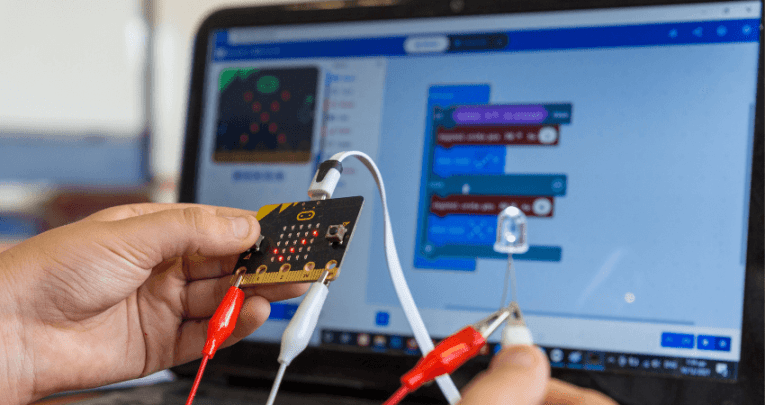Micro:bit – How to use this device to teach pupils coding

The BBC micro:bit is a mini-computer that’s impressively powerful…

- by Teachwire

Where can we find space in a crowded curriculum to teach employability skills for the future? Things like problem-solving, creativity, digital literacy and analytical thinking? The answer is coding – and the BBC micro:bit.
Getting your nerd on
Embedding coding in the primary classroom really isn’t as nerdy, or as niche, as you might think. After all, as Steve Jobs, a man who did fairly well for himself, once said: “Everyone in this country should learn how to program a computer… because it teaches you how to think”.
I, however, was born in the 80s. This was just after the time when it was important to teach kids how to build houses with their bare hands and before knowing that it was going to be important to learn how to work a computer.
So how did I become a teacher who could write an article on embedding coding in the primary classroom? The short answer is the BBC micro:bit – an impressively powerful mini-computer.
The protagonist
The BBC micro:bit fits perfectly in the palm of your hand. It’s equipped with 25 LEDs ready to light up the imagination and curiosity of a child. It also comes with a built–in microphone, radio, thermometer and speakers.
It can send radio signals up to 70 metres. You can use it to control several other devices, such as cars, arcade gaming devices and robotic dogs.
The radio transmitter allows you to send a message to over 100 devices at the same time. This is perfect if you need to send out an S.O.S. when you’re slowly drowning under a swell of paperwork.
But aside from transmitting rescue signals, what place does this tiny device have in a bustling primary classroom? How can it avoid becoming just another add-on that nobody has time for? Well, it all begins with tinkering.
The holy grail
A computational thinker is someone who can make predictions, analyse situations, make judgements, spot patterns and break things down into parts. One of the key approaches to developing these skills is through tinkering – changing things to see what happens.
However, when I first received my box of micro:bits I was too afraid to open it. The device looked like something from the inside of a computer, suitable only for someone who regularly clears cache data on their devices and actively rejects cookies (the digital ones, not custard creams).
Yet, once you insert the battery, a whole new world of wonder is released. The hardware is actually simple to set up and understand. And there are plenty of instructions and walkthroughs available for trepidatious teachers.
For me, this device had to add value to my teaching and learning and become something which I could embed across the curriculum.
To make this happen, I looked towards the Global Goals. These are 17 interlinked objectives to protect the planet, for now and the future, with the aim of eradicating poverty and inequality.
Coding goals
Consider Global Goal 3 (Good health and wellbeing), of ensuring that children are emotionally literate, getting exercise and confident to talk about their feelings.
The micro:bit can change a workout from a dreaded activity into an exciting game. You can create a pedometer in five minutes. Set a fun class challenge with a target linked to your topic, e.g. walk the length of the Titanic or the distance it takes to travel from our school to London Bridge.
And why not turn your micro:bits into sets of dice for PE activities: selecting a different exercise for each number? My class created relaxation devices and used these on our daily calm-down after lunch – a handy way to deal with all the issues resulting from playing football.
You can educate pupils about Goal 13 (climate action) by creating a device that will sound an alarm to remind people to switch off their lights.
More micro:bit ideas
Coding your micro:bit to gather data for a litter-pick adventure can help the children to focus on what is recyclable and non-recyclable, and generally help to manage behaviour when out and about in your local area.
You can use the micro:bit in music lessons, too. Enabling pupils to practise on a device rather than a musical instrument allows the children to focus clearly on which notes they need and how long they should play each. It’s a lot easier on teachers’ ears as well…
Developing innovation (Goal 9) can be furthered by having pupils create gaming devices. Simple games such as a coin toss can be used for class decision-making, and as a tool to assist with teaching probability.
The key to success is to think about what concepts you are trying to teach and how this little device can be used to support or reinforce learning experiences.
Once you consider the endless possibilities of the micro:bit and how it can be used in simple ways across the curriculum, your imagination can run wild. It might be small, but it’s a fantastic way to teach big ideas!
Introducing micro:bits to your class
- Pair pupils up in mixed-ability groupings so they can bounce ideas off each other and generally be there to provide support.
- Allow learners to engage in unplugged coding activities to develop their knowledge of the hows and whys of coding. This real-world application of skills is essential for developing understanding and making learning relevant to the world of work.
- It’s important to teach children to read code before writing it. Use the PRIMM approach to develop pupils’ understanding of code before they attempt to create their own.
- Provide a set of coding blocks for pupils to put together to assist learners in writing code, just like a word bank (makecode.microbit.org/blocks). This level of scaffolding helps pupils develop confidence and provides a supportive learning environment.
- Pupils can use the MakeCode website at home, as it has a micro:bit simulator and code-along tutorials. It’s ideal for the nervous teacher to practise with as well!
- Create plenty of opportunities for pupils to try enhancing existing code. This allows them to take risks, learn how to fail and bring themselves back up again. It develops a growth mindset and encourages pupils to challenge themselves and become more creative with their coding.
Laura Di Pasquale is a primary teacher, Apple learning coach and micro:bit champion based in Glasgow.











